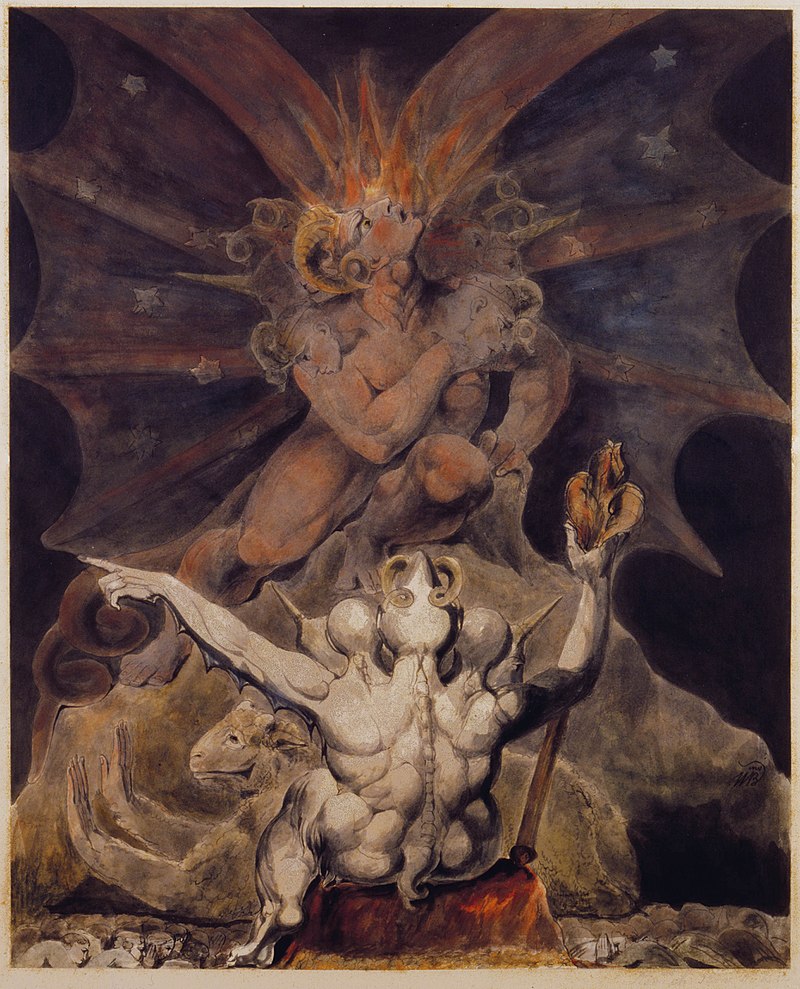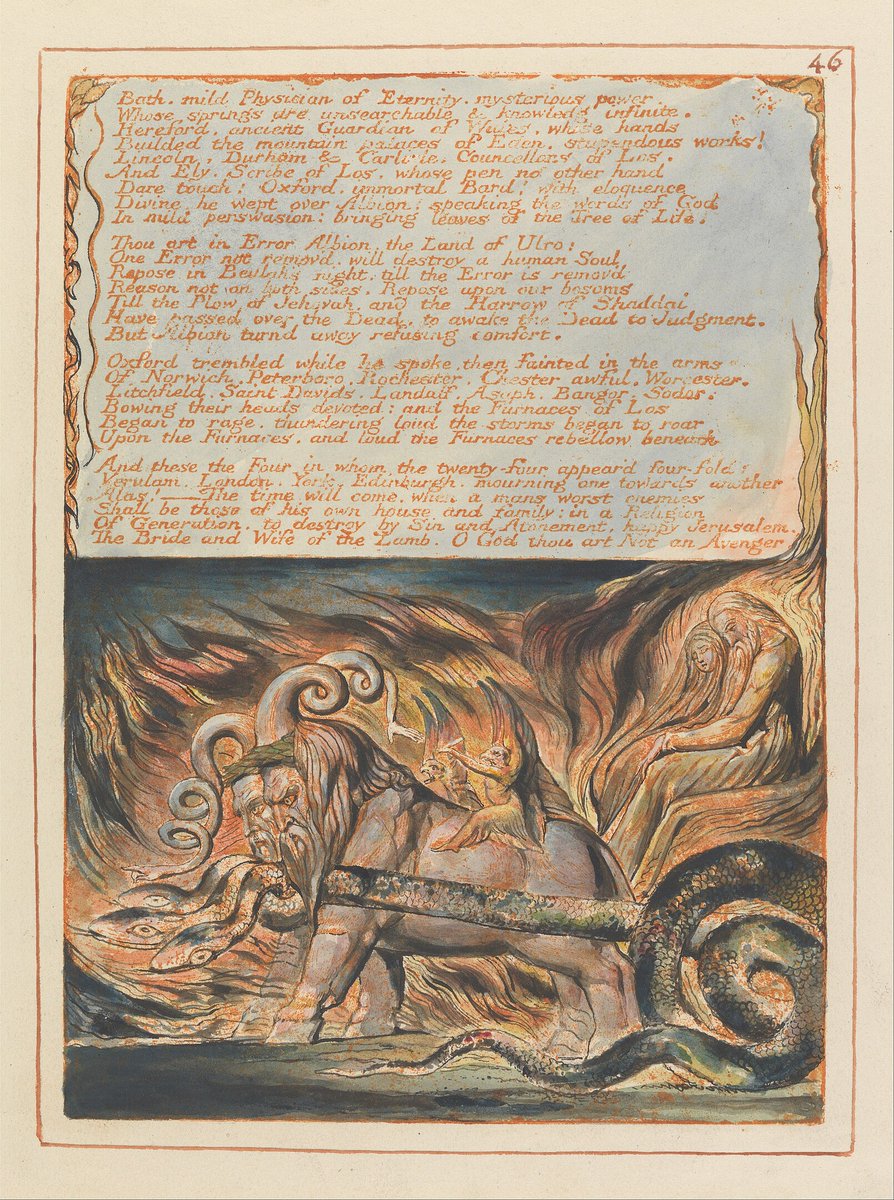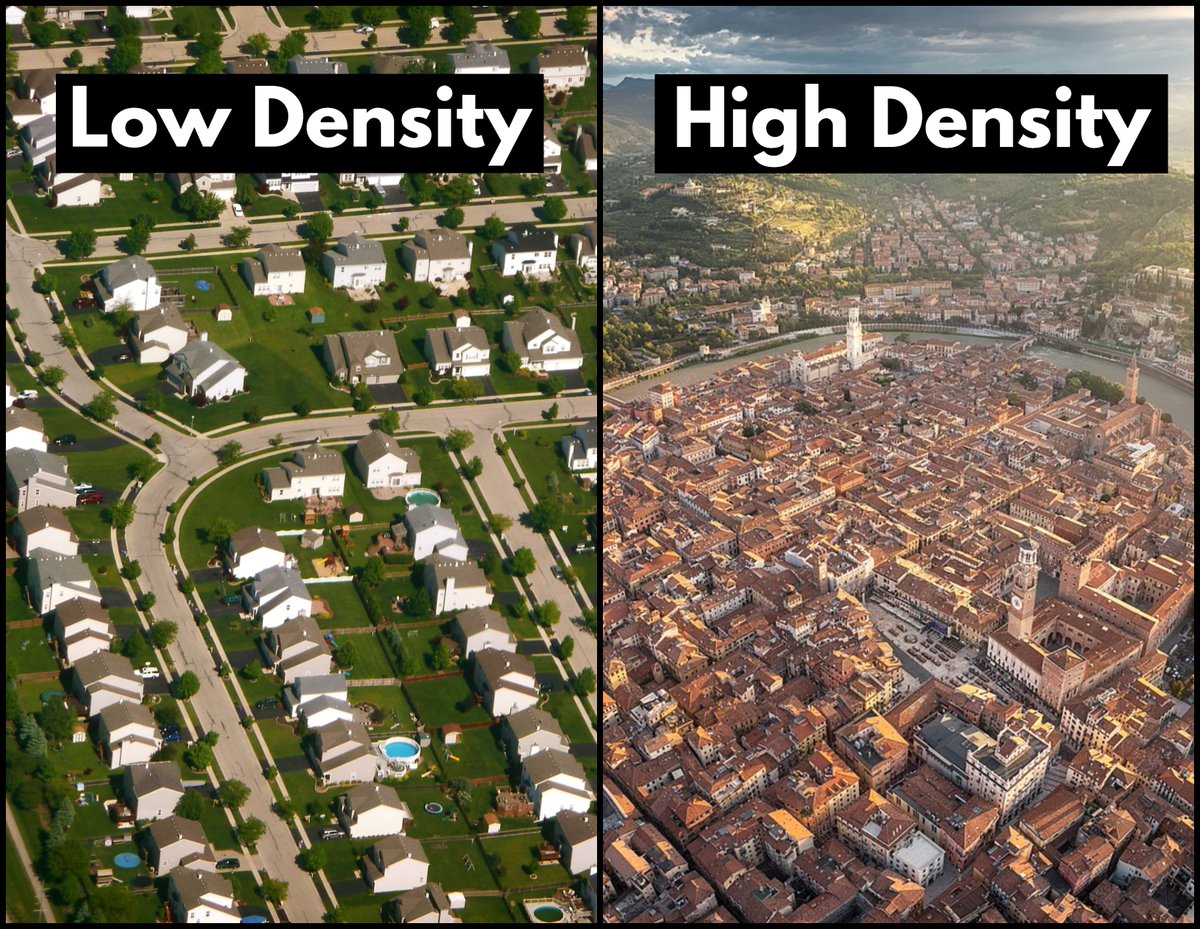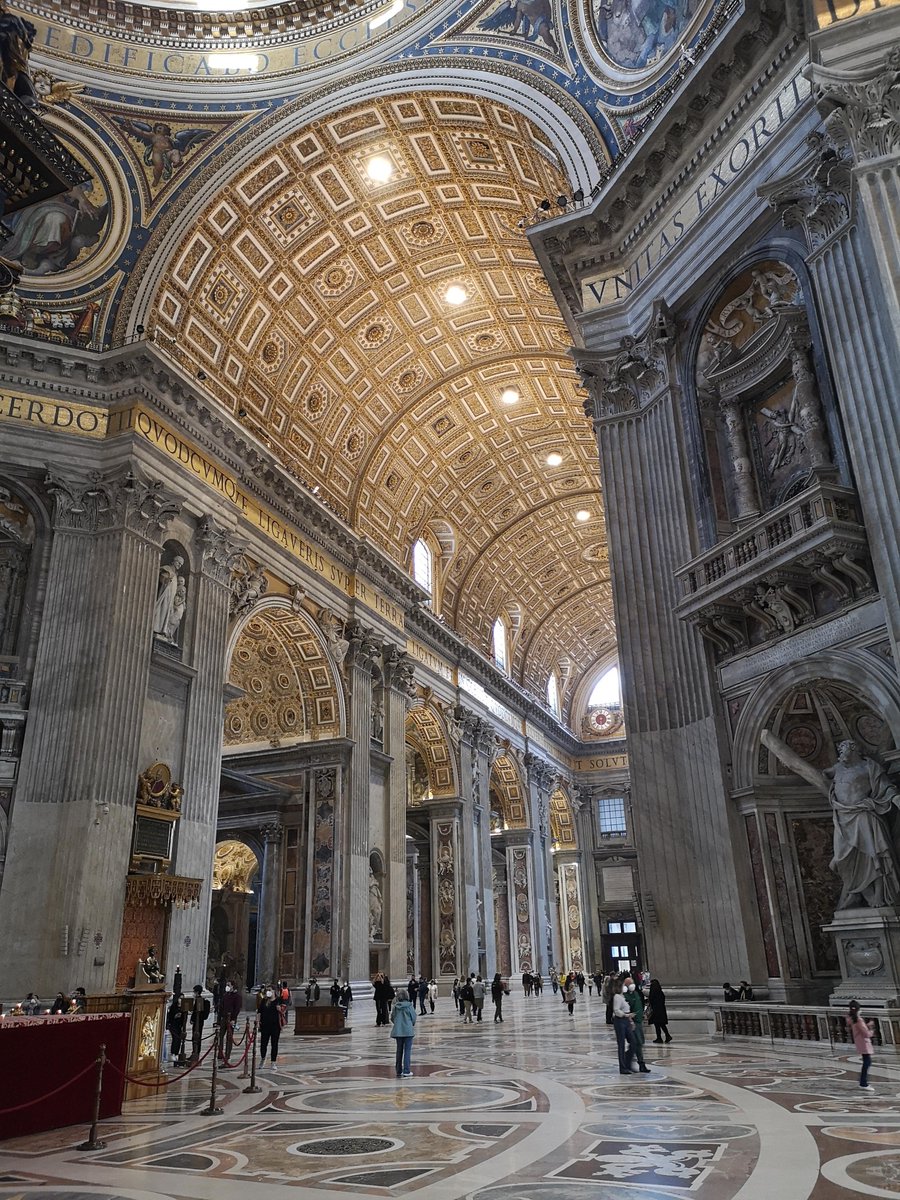266 years ago today one of the strangest artists in history was born: William Blake.
He was a poet, a prophet, a painter, a Romantic, an environmentalist, an abolitionist, and a mystic.
The word "unique" is overused, but William Blake truly was unlike any other...
He was a poet, a prophet, a painter, a Romantic, an environmentalist, an abolitionist, and a mystic.
The word "unique" is overused, but William Blake truly was unlike any other...

William Blake (1757-1827) has been called the greatest English artist who ever lived.
Not only for his paintings, but for his poetry, philosophy, prophecies, and incomprehensibly unique creative voice.
There has never been anybody like him before or since...
Not only for his paintings, but for his poetry, philosophy, prophecies, and incomprehensibly unique creative voice.
There has never been anybody like him before or since...

His style is almost uncategorisable. What genre or era do his paintings fall into?
Remember that he was living and working over two centuries ago. This looks far more modern, somehow mixing Expressionism with Symbolism and going even further afield into something else entirely.
Remember that he was living and working over two centuries ago. This looks far more modern, somehow mixing Expressionism with Symbolism and going even further afield into something else entirely.

Consider his depictions of scenes from the Bible.
People had been painting Bible art for centuries, but nobody had ever done it like this:
People had been painting Bible art for centuries, but nobody had ever done it like this:

That might be because William Blake had been experiencing religious visions ever since he was a young boy; thus he adopted a radical, unusual view of religion.
And these visions were the inspiration for many of his his paintings... like this one, The Ghost of a Flea.
And these visions were the inspiration for many of his his paintings... like this one, The Ghost of a Flea.

And even when he was painting a well-known subject, Blake stylised it in a way that looks as though it had come to him, personally, in a strange, mystical, intangible vision.
Consider his depiction of Canto V from Dante's Inferno; this has become Blake's Inferno.
Consider his depiction of Canto V from Dante's Inferno; this has become Blake's Inferno.

There is something both deeply disturbing and incredibly inspiring about Blake's art. It seems unshackled from any creative traditions or boundaries whatsoever.
He worked at home in London, all his life, writing and painting and printing his own books.
He worked at home in London, all his life, writing and painting and printing his own books.

William Blake also wrote several "prophecies."
These were sort of epic poems combined with illustrations, ranging in subject from apocalyptic predictions to theological treatises to fictional global revolutions.
These were sort of epic poems combined with illustrations, ranging in subject from apocalyptic predictions to theological treatises to fictional global revolutions.

This was the frontispiece to "America: A Prophecy", from 1793, in which Blake wrote about the oppression of the human mind and the failure of the American Revolution to truly liberate humanity... among other things. 

Blake also created his own, personal mythology.
There was a divine creator called Urizen who represented the rational part of mankind, and he wrote the "Book of Urizen", another collection of illustrated prophecies, about the creation of the universe and Urizen's children.
There was a divine creator called Urizen who represented the rational part of mankind, and he wrote the "Book of Urizen", another collection of illustrated prophecies, about the creation of the universe and Urizen's children.

This is just one page from the Book of Los:
"Los howld in a dismal stupor,
Groaning! gnashing! groaning!
Till the wrenching apart was healed.
But the wrenching of Urizen heal'd not..."
"Los howld in a dismal stupor,
Groaning! gnashing! groaning!
Till the wrenching apart was healed.
But the wrenching of Urizen heal'd not..."

And, to give you an idea of Blake's sheer imaginative range, take Milton.
It's an illustrated poem written in 1810 in which the poet John Milton comes down from Heaven to right Blake's own spiritual wrongs and explore how artists learn from their predecessors.


It's an illustrated poem written in 1810 in which the poet John Milton comes down from Heaven to right Blake's own spiritual wrongs and explore how artists learn from their predecessors.


Part of Milton was the poem which has since become known as "Jerusalem", set to music by Hubert Parry over a century later and now England's unofficial national anthem.
The Tyger, meanwhile, comes from a volume of illustrated poetry called Songs of Experience:
The Tyger, meanwhile, comes from a volume of illustrated poetry called Songs of Experience:

And then there's "Jerusalem: The Emanation of the Giant Albion", regarded as Blake's masterpiece.
It is poetry-allegory-prophecy with no linear plot and characters that are also places and ideas at the same time. Bonkers, brilliant, beautiful, beastly, beyond understanding.
It is poetry-allegory-prophecy with no linear plot and characters that are also places and ideas at the same time. Bonkers, brilliant, beautiful, beastly, beyond understanding.

Blake used these strange and mystical works — and his personal cosmology — to explore the conflict between rationality and imagination, the bounds of morality and religion, political ideals and human spirit, and more. 

To fully understand William Blake you need to know about the Industrial Revolution and the Age of Enlightenment.
He was fiercely opposed to both, and saw them as equal threats to the human spirit. Hence his famous, harrowing poem about 19th century London:
He was fiercely opposed to both, and saw them as equal threats to the human spirit. Hence his famous, harrowing poem about 19th century London:

This painting embodies his criticism of Isaac Newton, who represented for Blake everything wrong with the Enlightenment.
As somebody who experienced visions, Blake felt Newton's scientific explanation of light and optics was far narrower than what humans truly experienced.
As somebody who experienced visions, Blake felt Newton's scientific explanation of light and optics was far narrower than what humans truly experienced.

And that is what makes Blake so important and enduringly relevant.
He noticed the potentially devastating impact that technology might have on humanity and saw through the false promises of industrial politics.
He epitomises that instinctive human distrust of cold rationalism.
He noticed the potentially devastating impact that technology might have on humanity and saw through the false promises of industrial politics.
He epitomises that instinctive human distrust of cold rationalism.

Blake was especially aware of how industrialisation could atomise communities and turn cities into living hells.
And he feared that political revolutions had simply replaced monarchism with mercantilism. Money, rather than a single person, was the new king.
And he feared that political revolutions had simply replaced monarchism with mercantilism. Money, rather than a single person, was the new king.

But William Blake wasn't "anti-progress."
Quite the opposite: he was a fierce proponent of racial and sexuality equality, a furious critic of political oppression, a champion of human liberty to the end.
A shockingly modern artist whose views remain radical in the 21st century.


Quite the opposite: he was a fierce proponent of racial and sexuality equality, a furious critic of political oppression, a champion of human liberty to the end.
A shockingly modern artist whose views remain radical in the 21st century.


Blake's work — his paintings, prophecies, poetry, and illustrations — were almost completely ignored in his own lifetime.
He has since become, long after his death, a revered and studied (but rarely understood) artist.
He has since become, long after his death, a revered and studied (but rarely understood) artist.

But William Blake's prophetic poems still seem far beyond us; he was ahead of his own time, and still perhaps ahead of ours!
He was also an unfathomably prolific artist and his body of poetry and illustrations is colossal.
Easy to get lost in Blake's visions and prophecies..
He was also an unfathomably prolific artist and his body of poetry and illustrations is colossal.
Easy to get lost in Blake's visions and prophecies..

No short overview can ever do justice the sheer creative power of William Blake's mind.
The word unique is overused, but William Blake surely deserves to be called as such.
There has never been anybody quite like him, and perhaps there never will again.
The word unique is overused, but William Blake surely deserves to be called as such.
There has never been anybody quite like him, and perhaps there never will again.

• • •
Missing some Tweet in this thread? You can try to
force a refresh

 Read on Twitter
Read on Twitter























